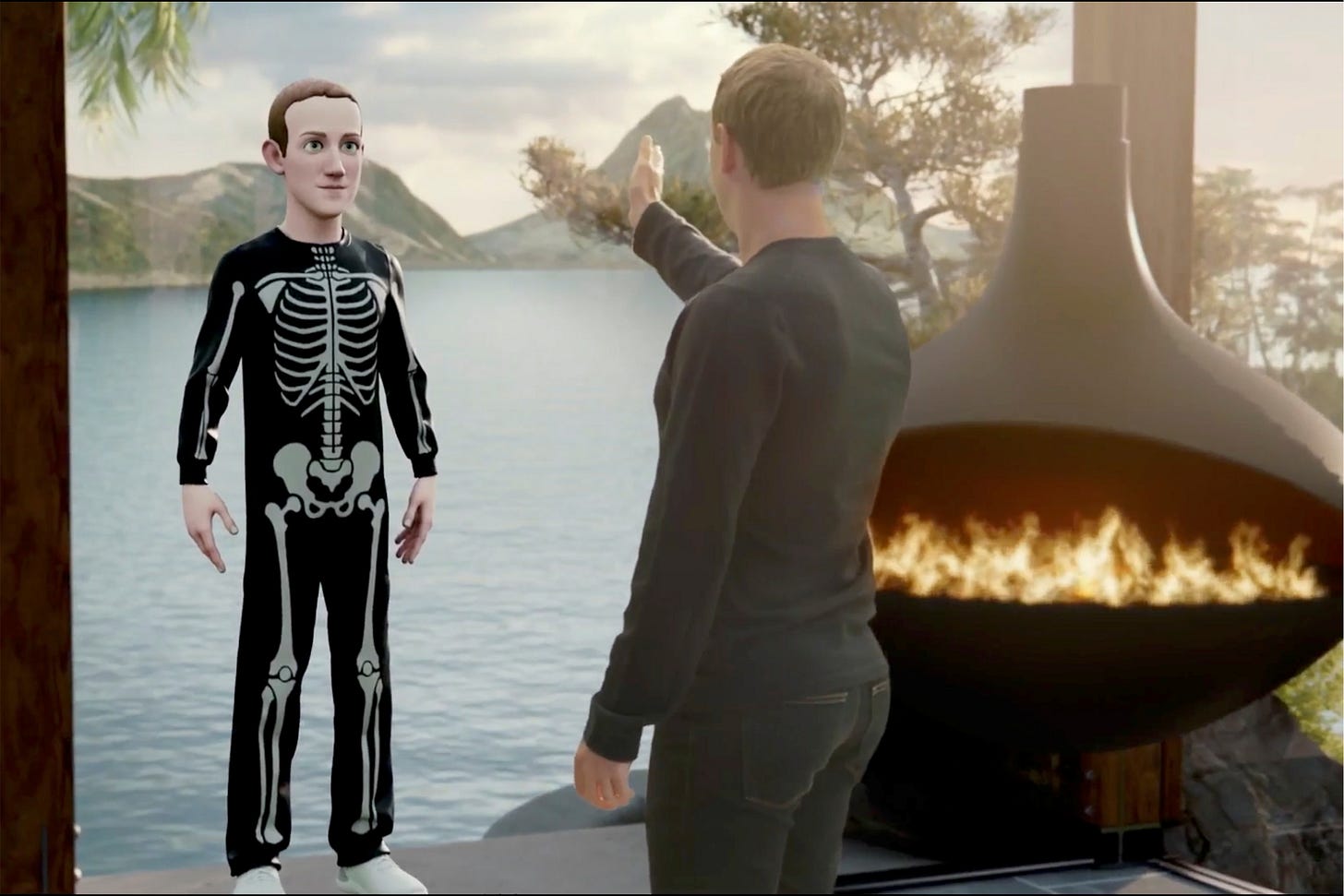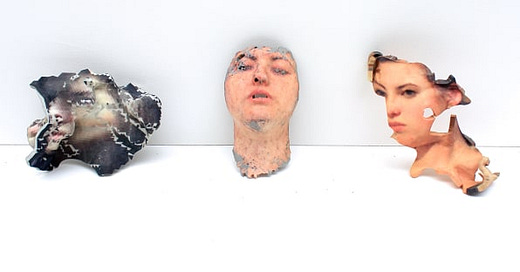Replicant, Avatar, Simulacra
copies no longer need originals, avatars will eventually become simulacra
Replicant
Freshman in college, I enrolled in an Art History class taught by professor Marek Wieczorek. One day in class, he showed us a 3D printed art project (below), called Replicants, by British art student Lorna Barnshaw.
This is a triptych of 3D printed facial studies called ‘replicants’, each created using a different computer application, software, and printing method as an output source. It is an exploration of reproducing human faces using a full-color 3D printer that binds sandstone powder with resin and colored ink, much like a standard inlet printer. Each of the three facial fragments, like the ruins of ancient sculptures, represents a different process of image capture and photo stitching for three-dimensional reconstruction. On the left, Barnshaw uses Cubify Capture to extract a very pixelated and distorted facial image from a video file. In the middle, the VIUscan 3D scanner generated the most lifelike result from the scanning process that suggests the onset of decomposition. On the right, Autodesk’s 123D Catch created a painterly but incomplete surface from 40 photos.
The most interesting piece to look at is the one made by 123D Catch – an AutoDesk software program that stitches 40 photos together and works best with patterned backgrounds. The face is so defined it makes it the most surreal. It is curved, contorted, stretched, and fractured in all directions, like a death mask.
The distortion happened because the software requires a patterned background for the results to work best and it struggled to define and stitch effectively. The digital objects had so many facets and points it was almost impossible to add thickness to the physical objects without adding any distortion. Interestingly, with the two faces on the opposite sides full of contortion and fragmentation, there’s still a strong recognition of the human face.
Replicants was inspired by this curiosity, namely by Ridley Scott’s prognosis in Blade Runner, this concept that we will one day create life-like, seamlessly integrated simulacrums of ourselves, “Replicants”.
“The replicants are distorted, some more than others, by the flaws in the technology used,” said Barnshaw, “I wanted to play with digital’s ability to copy reality – to put reality through a digital filter and back into material existence.” Replicants is disconnecting to the extent that its underlying technology is imperfect, yet the increasing sophistication of this technology may yield something more and make this art project conceptually rich.
2D photos don’t totally match with the 3D object. The captured reality was distorted reality. The new physical object has no distinctive form. It doesn’t retain the form of a human nor any preconception of how a human face would be, but yet the human face is still recognizable. Think about the digital’s ability to copy reality, the way it shapes us. We never have an expectation of how the virtual world would change us and never doubt the reality through a digital filter and back. Conceptually, the copied reality is like a self-portrait, a projection of us in the digital world and then back into the material existence, a believable simulacrum of a living being, more concrete than reality itself.
We all live our lives across two platforms, two worlds, the physical and the virtual. Replicants are 3D printed sculptures designed to test and portray the transition of information across both worlds.
Avatars
With the recent waves of the metaverse, I can’t help relating the Replicants to avatars.
The word avatar is ultimately derived from the Sanskrit word avatāra. In Hinduism, it stands for the descent of a deity into a terrestrial form. Neal Stephenson in his 1992 novel Snow Crash used the term avatar to mean online virtual bodies. In Snow Crash, which incidentally also introduced the metaverse concept, the avatar was used to describe the virtual simulation of the human form in the metaverse, a fictional virtual-reality application on the internet.
3 months ago, Mark Zuckerberg shared the vision for the metaverse—a place of new immersive experiences and the next evolution of social technology on FB connect 2021. This phenomenal conference featured 3D avatars that use artificial intelligence, sophisticated modeling techniques, and electromyography to render human features and movements accurately in a virtual space. "The goal here is to have both realistic and stylized avatars that create a deep feeling that we're present with people," Zuckerberg said during the live-streamed Facebook Connect '21 showcase.

In metaverse, we can choose a new shape of us: an avatar that can be stronger and prettier, having higher eyebrows or longer legs, even unconventionally looking face. We’ll have representation of ourselves achieving activities like surfing, skiing, mountaineering that we are not capable of in the real world. The avatars can also be invented with new personalities that are totally opposite from our real selves. Our avatars make avatars friends, collaborate in work, explore the virtual world… We can already foresee that we will soon have two selves, material ones and virtual copies, the copies that enable us to become who we want to be.
We are on the verge of a new world, a place where the virtual world becomes more and more real. Would one day we see the virtual world more concrete than reality? And hypervisibility becomes a new reality?
Simulacra
Jean Baudrillard worked on Simulacra in his famous book Simulacra and Simulation. Simulacra are copies that depict things that either had no original, or that no longer have an original. The line between the real and the altered is becoming harder to define, in Baudrillard’s words, the precession of simulacra has four stages1:
The first stage is a faithful image/copy, where we believe, and it may even be correct, that a sign is a "reflection of a profound reality".
The second stage is perversion of reality, this is where we come to believe the sign to be an unfaithful copy.
The third stage masks the absence of a profound reality, where the sign pretends to be a faithful copy, but it is a copy with no original.
The fourth stage is pure simulacrum, in which the simulacrum has no relationship to any reality whatsoever.
What was interesting was his conclusion that the simulacrum usurps reality, it dominates. It is not a representation but an ultimate model that was once based on reality, eventually losing all truth.
Sounds scary? This is not necessarily a bad thing. In the real world, we usually think of identity as singular instead of segmented. We are trying so hard to work out consistent personal branding. But people aren’t just one thing, they don’t need to have consistent branding the way a business does.
In the virtual world, the ability to customize how we want to be perceived can be incredibly empowering. It enables embodying rich personas to fit the environment and the circumstances. You might use one avatar for gaming, another in a professional setting, a third for a private space with your friends. It is like adopting a mask to shield your privacy and personal self from what you wish to make public. A female gamer can have both surreal avatar and surreal voice so that she doesn’t need to deal with misogyny and harassment. For people with disabilities, avatars can allow participants to pursue unique activities through which they can meet and interact with others. Your identity could be entirely different from however you’re in real world - copies no longer need originals, avatars will eventually become simulacra.
Resources:
Nina Azzarello, design boom , Aug 2013
The Replicants Are Coming: An Artist Creates Creepy 3-D Printed Faces, 2013
Kurt Opsahl and Katitza Rodriguez, Your Avatar is You, However You See Yourself, and You Should Control Your Experience and Your Data, Jun 2021
https://en.wikipedia.org/wiki/Simulacra_and_Simulation







Would one day we see the virtual world more concrete than reality? Maybe. But in the metaverse, there can never be any new natural science discoveries. We can be like gods and create as many worlds as we want, but whether we like it or not, the only reality is right there.
—Argued by someone majoyed in physics